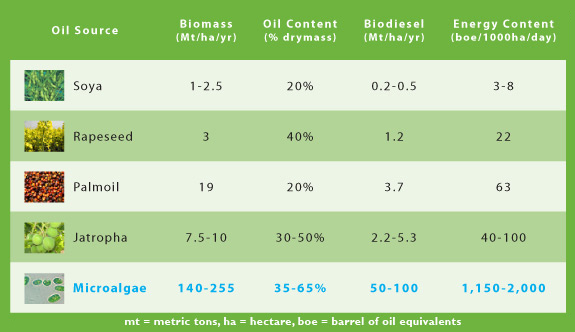Microalgae Provide a Cost-effective and More Sustainable Supply of Oil
Algal biomass consists of natural oils, proteins, and carbohydrates. Many species of algae can produce oils comprising up to 35% or more of their dry weight. Oil produced from algae is very similar in structure to oil derived from plants and vegetables such as soy, palm, and rapeseed. Oils, along with fats, are composed of triglycerides–three fatty acids attached to a glycerol. Normally oils are liquid at room temperature and fats are solid.
Because algae oil is a triglyceride, it can be converted to a variety of high value commodity products, primarily biofuels such as biodiesel, through the same processes used to convert vegetable oils. For example, transesterification of vegetable oil to biodiesel is identical to that of transforming algae oil to biodiesel. Alternatively, the feedstock oil derived from algae can be hydro-treated to produce bio-alkanes such as gasoline or JP-8 and other jet fuels.
Oil accumulation in algae typically occurs during periods of environmental stress, including growth under nutrient-deficient conditions. In the open-pond growth phase of Cellana’s algae production system, we purposely create a nutrient-deficient environment in order to maximize oil production.
Algae Offer Many Advantages Over Traditional Oilseed Crops Such as Corn, Soybeans or Rapeseed
The table below provides an analysis of the composition and energy potential of terrestrial, first-generation energy crops versus compared to the next-generation energy crop, microalgae.

The advantages of algae include over traditional terrestrial oilseed crops include:

